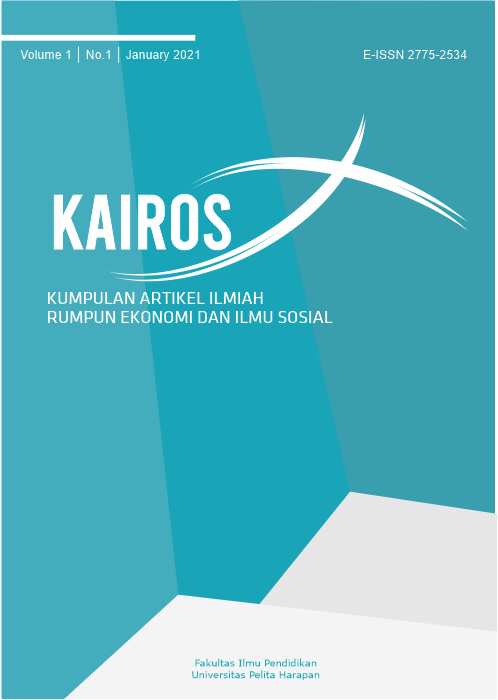Penerapan Integrasi Iman Kristen Model Bryan Smith Tahapan 2 Dalam Pelajaran Ekonomi Kelas X SMA [Application of Stage 2 of Bryan Smith's Model of Christian Faith Integration in an Economics Class for 10th Grade Students]
DOI:
https://doi.org/10.19166/kairos.v1i1.3162Kata Kunci:
Christian faith, Bryan Smith’s model stage 2, Integration, Iman Kristen, Integrasi, Model Bryan Smith tahap 2, Christian faith integration, economicsAbstrak
This paper aims to discuss how the application of the Christian faith integration in the learning process can achieve the goals of Christian education. The goals of Christian education are to carry out the vision of the Great Commission which is to make disciples and lead students to Christ. To achieve these goals, schools must commit to progress based on Bible truth and Christ centered. This will be seen in the implementation of Christian faith integration in the whole of the set curriculum. Based on observations made at a Christian school in the Jakarta area, the author sees that the integration of Christian faith does not occur in the learning process. This fact makes students miss the opportunity to know Christ through all the knowledge they have learned. Responding to these problems, the authors try to apply the Bryan Smith model integration stage 2 in class X, economics lessons. The writing method used to compile this paper is the study of literature and field observations. The application of the integration of Christian faith in learning is very important to achieve the goals of Christian education. With integration, students can see the real greatness of God in every discipline, including economics. Through this paper, it is hoped that Christian educators can realize their roles and responsibilities in integrating Christian faith as part of carrying out the call to the Great Commission of Christ.
BAHASA INDONESIA ABSTRACT: Tulisan ini bertujuan untuk membahas bagaimana penerapan integrasi iman Kristen dalam proses pembelajaran dapat mencapai tujuan pendidikan Kristen. Tujuan pendidikan Kristen adalah menjalankan visi amanat Agung yaitu memuridkan dan menggerakkan siswa kepada Kristus. Untuk mencapai tujuan tersebut, sekolah harus berkomitmen untuk berlangsung dengan berlandaskan kebenaran Alkitab dan berpusat kepada Kristus. Hal tersebut akan terlihat dalam implementasi integrasi iman Kristen dalam seluruh rangkaian kurikulum. Berdasarkan observasi yang telah dilakukan di sebuah sekolah Kristen di daerah Jakarta, penulis melihat bahwa integrasi iman Kristen tidak terjadi dalam proses pembelajaran. Hal ini membuat siswa kehilangan kesempatan untuk mengenal Kristus melalui seluruh ilmu pengetahuan yang mereka pelajari. Menyikapi masalah tersebut, penulis mencoba menerapkan integrasi model Bryan Smith tahapan 2 di kelas X pelajaran ekonomi. Metode penulisan yang dipakai untuk menyusun karya tulis ini adalah kajian literatur dan observasi lapangan. Penerapan integrasi iman Kristen dalam pembelajaran sangat penting untuk mencapai tujuan Pendidikan Kristen. Dengan integrasi, siswa dapat melihat kebesaran Allah secara nyata dalam setiap disiplin ilmu, termasuk ilmu ekonomi. Melalui tulisan ini diharapkan para pendidik Kristen dapat menyadari peran dan tanggung jawab mereka dalam mengintegrasi iman Kristen sebagai bagian dalam mengerjakan panggilan Amanat Agung Kristus.
Referensi
Adhi, Y., Winardi, Y., & Listiani, T. (2018). Penerapan model integrasi Biblika Bryan Smith tahap 2 pada pembelajaran matematika untuk meningkatkan pemahaman wawasan Kristen Alkitabiah ( WAK ) siswa kelas XI IPA-2 di suatu SMA di Toraja [ The implementation of the Bryan Smith stage 2 Biblical integra. JOHME: Journal of Holistic Mathematics Education, 2(1), 45-56. https://doi.org/10.19166/johme.v2i1.979
Berkhof, L., & Til, C. Van. (2010). Dasar pendidikan Kristen: Ceramah-ceramah kepada guru-guru Kristen. Surabaya, Indonesia: Penerbit Momentum.
Bitgood, G. (n.d.). All truth is God's truth: heritage Christian school's. Philosophy of Biblical Integration in School Curruculum.
Brummelen, H. van. (2008). Batu loncatan kurikulum berdasarkan Alkitab. Tangerang, Indonesia: UPH Press.
Collier, J. (2013). Models of Christian education. TEACH Journal of Christian Education, 7(1), 4-7. https://doi.org/10.55254/1835-1492.1194
Don, R. (2013). Is Christian education really 'ministry'? TEACH Journal of Christian Education, 7(1), 14-19. https://doi.org/10.55254/1835-1492.1196
Dyk, J. Van. (2013). Surat-surat untuk Lisa: percakapan dengan seorang guru Kristen. Tangerang, Indonesia: UPH Press.
Hasoloan, J. (2010). Pengantar ilmu ekonomi. Yogyakarta, Indonesia: Deepublish.
Hendricks, H. (2016). Mengajar untuk mengubah hidup. Yogyakarta, Indonesia: Yayasan Gloria.
Knight, G. R. (2009). Filsafat & pendidikan: sebuah pendahuluan dari perspektif Kristen. Tangerang, Indonesia: UPH Press.
McGrath, A. E. (2010). Science and religion: A new introduction. Oxford, UK: Blackwell Publishers.
Melvin, H. (2006). Comprehensive Biblical integration. CBAR, 1(1), 41-49. Retrieved from https://cbfa-cbar.org/index.php/cbar/article/view/6
Roller, R. H. (2015). Twenty-one methods of Biblical faith-learning integration. JBIB, 16(2). https://doi.org/10.69492/jbib.v16i2.130
Sitorus, J. P. (2019). Wawasan dunia Kristen dan dunia ilmu pengetahuan terhadap bahasa (2nd ed.). Malang, Indonesia: Penerbit Evernity.
Smith, B. (2016). Biblical integration: pitfalls and promise.
Theron, P. M., & Lotter, G. A. (2009). The necessity of an integral Christian worldview : reconnoitring the challenges for influencing the unbelieving world. Koers, 74(3), 467-493. https://doi.org/10.4102/koers.v74i3.134
Tung, K. Y. (2015). Menuju sekolah Kristen impian masa kini. Yogyakarta, Indonesia: Penerbit ANDI.
Tung, K. Y. (2016). Terpanggil menjadi pendidik Kristen yang berhati gembala. Yogyakarta, Indonesia: Penerbit ANDI.
Wolterstorff, N. P. (2014). Mendidik untuk kehidupan: Refleksi mengenai pengajaran dan pembelajaran Kristen (III). Surabaya, Indonesia: Penerbit Momentum.
Unduhan
Diterbitkan
Cara Mengutip
Terbitan
Bagian
Lisensi
Hak Cipta (c) 2021 Yulinar Br Bangun, Budi Wibawanta

Artikel ini berlisensiCreative Commons Attribution-ShareAlike 4.0 International License.
Authors who publish with this journal agree to the following terms:
1) Authors retain copyright and grant the journal right of first publication with the work simultaneously licensed under a Creative Commons Attribution License (CC-BY-SA 4.0) that allows others to share the work with an acknowledgement of the work's authorship and initial publication in this journal.
2) Authors are able to enter into separate, additional contractual arrangements for the non-exclusive distribution of the journal's published version of the work (e.g., post it to an institutional repository or publish it in a book), with an acknowledgement of its initial publication in this journal.
3) Authors are permitted and encouraged to post their work online (e.g., in institutional repositories or on their website). The final published PDF should be used and bibliographic details that credit the publication in this journal should be included.




